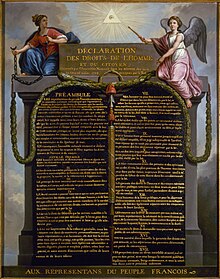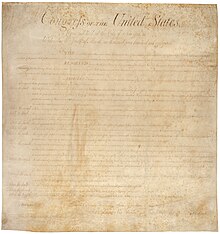Haklar Bildirgesi: Revizyonlar arasındaki fark
Cartsterta (mesaj | katkılar) "Bill of rights" sayfasının çevrilmesiyle oluşturuldu. Etiketler: İçerik Çevirmeni İçerik Çevirmeni 2 |
(Fark yok)
|
Sayfanın 11.51, 14 Ocak 2024 tarihindeki hâli


Haklar Bildirgesi, temel haklar bildirgesi, haklar beyannamesi veya haklar şartnamesi, bir ülkenin vatandaşlarına ait en önemli hakları içeren bir listedir. Amacı, bu hakları kamu görevlileri ve özel vatandaşlar tarafından ihlallere karşı korumaktır.[1]
Haklar bildirgeleri köklü veya köksüz olabilir. Köklü bir haklar bildirgesi, herhangi bir ülkenin yasama organı tarafından değiştirilemez veya iptal edilemez; bunun yerine genellikle bir ülkenin anayasasının bir parçasıdır ve bu nedenle anayasanın değiştirilmesi için geçerli olan özel prosedürlere tabidir.
Tarihçe
Belirli gruplar için belirli hakları savunan yasal bildirgeler Orta Çağ'dan beri vardır. Bir örnek, 1215 yılında Kral ve baronları arasında imzalanan İngiliz yasal bildirge olan Magna Carta'dır.[2] Magna Carta, erken modern çağda tekrardan uluslararası çapta ilgi görmeye başladı.[3][4] İngiliz ortak hukuk yargıcı Sör Edward Coke, vatandaşlık temelinde haklar fikrini vurgularken, İngilizlerin tarih boyunca bu haklardan yararlandığını söyledi. 1628'deki Haklar İçin Dilekçe, 1679 İhzar müzekkeresi hareketi ve 1689'daki Haklar Beyannamesi, belirli hakları yasal olarak belirlemiştir.
On Üç Koloni'de İngiliz Haklar Beyannamesi, 1776 Virginia Haklar Bildirgesi'ni tetikleyen nedenlerden biriydi. Aynı yılın ilerleyen dönemlerinde Amerika Birleşik Devletleri Bağımsızlık Bildirgesi'ni etkiledi.[5][6] Amerika Birleşik Devletleri Anayasası 1789'da kabul edildikten sonra, Amerika Birleşik Devletleri Haklar Bildirgesi 1791'de onaylandı. ABD Anayasası ve Haklar Bildirgesi İngiliz anayasa tarihinden etkilenmiştir.[7][8][9]
Aydınlanma Çağından ilham alan İnsan ve Yurttaş Hakları Bildirgesi, hakların evrenselliğini öne sürüyordu.[10] Fransız Devrimi döneminde, 1789 yılında Fransa Ulusal Kurucu Meclisi tarafından kabul edildi.
20. yüzyılda farklı grupların İnsan Hakları Evrensel Beyannamesi, Avrupa İnsan Hakları Sözleşmesi ve Birleşmiş Milletler Çocuk Hakları Sözleşmesi'nin taslağını hazırlarken bu eski belgelerden yararlandıkları görüldü.[11]
Demokrasilerde istisnalar
Birleşik Krallık Anayasası yazılmamıştır.[12] Bununla birlikte, 1689 tarihli Haklar Bildirgesi Birleşik Krallık yasalarına dahildir. 1998 İnsan Hakları Yasası, Avrupa İnsan Hakları Sözleşmesi'nde belirtilen hakları Birleşik Krallık yasalarına dahil eder. Yeni Yüksek Mahkeme, özgürlük, demokrasi ve hukukun üstünlüğüne yönelik son ihlaller nedeniyle Birleşik Krallık Hakları Bildirgesini yeniden ele almak ve hükümetin yasalarını ve politikalarını iptal etme yetkisine sahiptir.[13]
Avustralya, birçok eyalette devam eden tartışmalar olmasına rağmen, vatandaşlarını korumaya yönelik ne anayasal ne de federal yasama haklarına sahip olan tek ortak hukuk ülkesidir.[14][15] 1973'te Federal Başsavcı Lionel Murphy, hiçbir zaman kabul edilmemesine rağmen parlamentoya bir insan hakları yasa tasarısı sundu.[16] 1984'te Senatör Gareth Evans bir Haklar Bildirgesi taslağı hazırladı, ancak bu hiçbir zaman parlamentoya sunulmadı ve 1985'te Senatör Lionel Bowen, Temsilciler Meclisi tarafından kabul edilen ancak Senato'dan geçemeyen bir haklar bildirgesi sundu.[16] Eski Avustralya Başbakanı John Howard, gücün seçilmiş politikacılardan seçilmemiş yargıçlara ve bürokratlara devredileceği gerekçesiyle Avustralya'ya yönelik bir haklar bildirgesine karşı çıktı.[17][18] Victoria, Queensland ve Avustralya Başkent Bölgesi (ACT), insan hakları yasasına sahip tek eyalet bölgeleridir.[19] Bununla birlikte, Avustralya yargı sisteminde mevcut olan yasallık ilkesi, mevzuat açıkça müdahale etme niyetinde olmadığı sürece mevzuatın temel insan haklarına müdahale etmeyecek şekilde yorumlanmasını sağlamayı amaçlamaktadır.
Bildirge listesi

| Title | Effective Year | Realm | Notes |
|---|---|---|---|
| Charter of Liberties | 1100 | Rights of inheritance and marriage, amnesty, and environmental protection | |
| Magna Carta | 1215 | Rights for barons | |
| Great Charter of Ireland | 1216 | Şablon:Ülke veri Lordship of Ireland | Rights for barons |
| Golden Bull of 1222 | 1222 | Rights for nobles | |
| Statute of Kalisz | 1264 | Jewish residents' rights | |
| Charter of Kortenberg | 1312 | Rights for all citizens "rich and poor" | |
| Dušan's Code | 1349 | ||
| Twelve Articles | 1525 | Swabian League | |
| Pacta conventa | 1573 | ||
| Henrician Articles | 1573 | ||
| Petition of Right | 1628 | ||
| Declaration of Right, 1689 Bill of Rights 1689 Claim of Right Act 1689 |
1689 | This applied to all British Colonies of the time, and was later entrenched in the laws of those colonies that became nations—for instance in Australia with the Colonial Laws Validity Act 1865 and reconfirmed by the Statute of Westminster 1931 | |
| Virginia Declaration of Rights | 1776 | June 1776, Preamble to the United States Declaration of Independence, July 1776 | |
| Chapter 1 of the Pennsylvania Constitution | 1776 | July 1776[20] | |
| Declaration of the Rights of Man and of the Citizen | 1789 | ||
| Bill of Rights of the United States Constitution | 1791 | Completed in 1789, ratified in 1791 | |
| Declaration of the Rights of the People | 1811 | ||
| Article I of the Constitution of Connecticut | 1818 | ||
| Constitution of Greece | 1822 | Şablon:Ülke veri First Hellenic Republic | |
| Hatt-ı Hümayun | 1856 | ||
| Article I of the Constitution of Texas | 1875 | ||
| Basic rights and liberties in Finland | 1919 | ||
| Implied Bill of Rights (a theory in Canadian constitutional law) | 1938 | The bill of rights implied by the Constitution Act, 1867, first identified in Reference Re Alberta Statutes in 1938. | |
| Articles 13-28 of the Constitution of Italy | 1947 | ||
| Universal Declaration of Human Rights | 1948 | ||
| Fundamental rights and duties of citizens in People's Republic of China | 1949 | ||
| Fundamental Rights of Indian citizens | 1950 | ||
| European Convention on Human Rights | 1953 | Şablon:Ülke veri Council of Europe | Drafted in 1950 |
| Canadian Bill of Rights | 1960 | ||
| Part I of the Constitution of Portugal | 1976 | ||
| International Bill of Human Rights | 1976 | ||
| Quebec Charter of Human Rights and Freedoms | 1976 | ||
| Canadian Charter of Rights and Freedoms | 1982 | ||
| Declaration of the Basic Duties of ASEAN Peoples and Governments | 1983 | Signed in Manila by the Regional Council on Human Rights in Asia, the first to draft a pan-Asian declaration of human rights | |
| Article III and XIII of the Constitution of the Philippines | 1987 | The Bill of Rights encapsulating Article III regulates duties and responsibilities of the government toward the rights of citizens, while Article XIII is specifically about human rights and social justice | |
| Article 5 of the Constitution of Brazil | 1988 | ||
| New Zealand Bill of Rights Act | 1990 | ||
| Charter of Fundamental Rights and Basic Freedoms of the Czech Republic | 1991 | ||
| Hong Kong Bill of Rights Ordinance | 1991 | ||
| Chapter 2 of the Constitution of South Africa | 1996 | Entitled "Bill of Rights" | |
| Human Rights Act 1998 | 1998 | ||
| Human Rights Act 2004 | 2004 | ||
| Charter of Fundamental Rights of the European Union | 2005 | ||
| Victorian Charter of Human Rights and Responsibilities | 2006 | ||
| Chapter Four of the Constitution of Zimbabwe | 2013 | ||
| Queensland Human Rights Act 2018 | 2019 |
Ayrıca bakınız
Kaynakça
- ^ Sellers, Mortimer N. S. (2013). "Universal Human Rights Law in the United States". Haeck, Yves; Brems, Eva (Ed.). Human Rights and Civil Liberties in the 21st Century. Ius Gentium: Comparative Perspectives on Law and Justice. 30. Dordrecht: Springer Netherlands. ss. 15–35. doi:10.1007/978-94-007-7599-2_2. ISBN 978-94-007-7598-5.
- ^ Rau, Zbigniew; Żurawski vel Grajewski, Przemysław; Tracz-Tryniecki, Marek, (Ed.) (2016). Magna Carta: A Central European Perspective of Our Common Heritage of Freedom. Rutledge. s. xvi. ISBN 978-1317278597.
Britain in its history proposed many pioneering documents - not only Magna Carta, 1215 but those such as the Provisions of Oxford 1258, the Petition of Right 1628, the Bill of Rights 1689, and the Claim of Right 1689
- ^ "From legal document to public myth: Magna Carta in the 17th century". The British Library. Erişim tarihi: 2017-10-16
- ^ "Magna Carta: Magna Carta in the 17th Century". The Society of Antiquaries of London. 2018-09-25 tarihinde kaynağından arşivlendi. Erişim tarihi: 2017-10-16.
- ^ "Constitutionalism: America & Beyond". Bureau of International Information Programs (IIP), U.S. Department of State. 24 October 2014 tarihinde kaynağından arşivlendi. Erişim tarihi: 30 October 2014.
The earliest, and perhaps greatest, victory for liberalism was achieved in England. The rising commercial class that had supported the Tudor monarchy in the 16th century led the revolutionary battle in the 17th and succeeded in establishing the supremacy of Parliament and, eventually, of the House of Commons. What emerged as the distinctive feature of modern constitutionalism was not the insistence on the idea that the king is subject to law (although this concept is an essential attribute of all constitutionalism). This notion was already well established in the Middle Ages. What was distinctive was the establishment of effective means of political control whereby the rule of law might be enforced. Modern constitutionalism was born with the political requirement that representative government depended upon the consent of citizen subjects... However, as can be seen through provisions in the 1689 Bill of Rights, the English Revolution was fought not just to protect the rights of property (in the narrow sense) but to establish those liberties which liberals believed essential to human dignity and moral worth. The "rights of man" enumerated in the English Bill of Rights gradually were proclaimed beyond the boundaries of England, notably in the American Declaration of Independence of 1776 and in the French Declaration of the Rights of Man in 1789.
- ^ Maier, Pauline (1997). American Scripture: Making the Declaration of Independence. New York: Knopf. ss. 126–28. ISBN 0-679-45492-6.
- ^ Schwartz, Bernard (1992). The Great Rights of Mankind: A History of the American Bill of Rights. Rowman & Littlefield. ss. 1–2. ISBN 9780945612285.
- ^ Conley, Patrick T.; States, U. S. Constitution Council of the Thirteen Original (1992). The Bill of Rights and the States: The Colonial and Revolutionary Origins of American Liberties. Rowman & Littlefield. ss. 13–15. ISBN 9780945612292.
- ^ Montoya, Maria; Belmonte, Laura A.; Guarneri, Carl J.; Hackel, Steven; Hartigan-O'Connor, Ellen (2016). Global Americans: A History of the United States. Cengage Learning. s. 116. ISBN 9780618833108.
- ^ Liberty, Equality, Fraternity: Exploring the French Revolution. Penn State Press. 2001. ISBN 0271040130.
- ^ Hugh Starkey, Professor of Citizenship and Human Rights Education at UCL Institute of Education, London. "Magna Carta and Human rights legislation". British Library. Erişim tarihi: 22 November 2016.
- ^ Rau, Zbigniew; Żurawski vel Grajewski, Przemysław; Tracz-Tryniecki, Marek, (Ed.) (2016). Magna Carta: A Central European Perspective of Our Common Heritage of Freedom. Rutledge. s. xvi. ISBN 978-1317278597.
Britain in its history proposed many pioneering documents - not only Magna Carta, 1215 but those such as the Provisions of Oxford 1258, the Petition of Right 1628, the Bill of Rights 1689, and the Claim of Right 1689
- ^ Abbott, Lewis F. (2019). Defending Liberty: The Case for a New Bill of Rights. Industrial Systems Research. Erişim tarihi: December 4, 2021.
- ^ Suter, Keith (18 July 2008). "Does Australia need a Bill of Rights?". Wesley Mission. 2013-11-10 tarihinde kaynağından arşivlendi.
- ^ Anderson, Deb (21 September 2010). "Does Australia need a bill of rights?". The Age. Melbourne.
- ^ a b "Part Four: A Human Rights Act?" (PDF). 2014-02-13 tarihinde kaynağından (PDF) arşivlendi. Erişim tarihi: 2014-10-26.
- ^ "Howard opposes Bill of Rights". PerthNow. The Sunday Times. 2009-08-27. Erişim tarihi: 2009-09-14.[ölü/kırık bağlantı]
- ^ Howard, John (2009-08-27). "2009 Menzies Lecture by John Howard (full text)". The Australian. News Limited. 2009-08-30 tarihinde kaynağından arşivlendi. Erişim tarihi: 2009-09-14.
- ^ "Human Rights Act 2019". legislation.qld.gov.au. Queensland Government. 7 March 2019. Erişim tarihi: 4 April 2019.
- ^ "Constitution of the Commonwealth of Pennsylvania - 1776". Duquesne University. October 21, 2016 tarihinde kaynağından arşivlendi. Erişim tarihi: December 29, 2016.
